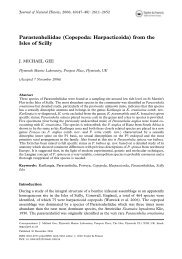An Updated Classification of the Recent Crustacea
An Updated Classification of the Recent Crustacea
An Updated Classification of the Recent Crustacea
Create successful ePaper yourself
Turn your PDF publications into a flip-book with our unique Google optimized e-Paper software.
fication (see also Negrea et al., 1999). Therefore,<br />
with trepidation and against our own recommendations<br />
(Martin and Christiansen, 1995a), we have<br />
resurrected <strong>the</strong> name Phyllopoda, using it this time<br />
to include <strong>the</strong> extant Notostraca and <strong>the</strong> bivalved<br />
branchiopod groups (i.e., all branchiopods except<br />
<strong>the</strong> <strong>An</strong>ostraca). We have credited <strong>the</strong> taxon name<br />
to Preuss (1951), who was, to our knowledge, <strong>the</strong><br />
first person to use <strong>the</strong> name Phyllopoda in <strong>the</strong> sense<br />
that we are using it (to contain all branchiopods<br />
o<strong>the</strong>r than <strong>the</strong> anostracans). This decision will surely<br />
prompt arguments from many current students<br />
<strong>of</strong> <strong>the</strong> Branchiopoda (see especially Fryer, 1987c,<br />
1995, 1999b).<br />
There have been many significant findings in extant<br />
and extinct branchiopods that have altered our<br />
view <strong>of</strong> branchiopod relationships since <strong>the</strong> Bowman<br />
and Abele (1982) classification. Morphological<br />
treatments have included Fryer (1983, 1985,<br />
1987a–c, 1995, 1996a, b, 1999), Martin (1992),<br />
Martin and Cash-Clark (1995), Walossek (1993,<br />
1995), Olesen et al. (1997), Olesen (1996, 1998,<br />
1999), Thiéry (1996), Amoros (1996), and Negrea<br />
et al. (1999), to mention only a few <strong>of</strong> <strong>the</strong> recent<br />
papers. There have also been several attempts to<br />
deduce branchiopod relationships using molecular<br />
data, including Hanner and Fugate (1997) and<br />
Spears and Abele (1997, 1998, 1999b, 2000). In<br />
<strong>the</strong> current classification, we have attempted to reconcile<br />
some <strong>of</strong> <strong>the</strong> recent morphological and molecular<br />
findings, but earlier classifications should<br />
not be discarded as being out <strong>of</strong> date or invalid.<br />
Indeed, many <strong>of</strong> <strong>the</strong> most detailed accounts <strong>of</strong><br />
branchiopods remain <strong>the</strong> older, classical treatments,<br />
and to ignore <strong>the</strong>se is a grave mistake. Thiéry<br />
(1996, based in large part on Martin, 1992) reviewed<br />
<strong>the</strong> biology <strong>of</strong> <strong>the</strong> noncladoceran groups<br />
(including Cycles<strong>the</strong>ria among <strong>the</strong> conchostracans),<br />
and Amoros (1996) reviewed <strong>the</strong> four ‘‘former cladoceran’’<br />
orders Ctenopoda, <strong>An</strong>omopoda, Onychopoda,<br />
and Haplopoda.<br />
SUBCLASS SARSOSTRACA, ORDER<br />
ANOSTRACA<br />
Within <strong>the</strong> <strong>An</strong>ostraca, Brtek (1995) elevated <strong>the</strong><br />
former chirocephalid subfamily Artemiopsinae to<br />
family level and thus recognized <strong>the</strong> Artemiopsidae.<br />
Earlier, Brtek (1964) established <strong>the</strong> family Linderiellidae.<br />
However, Denton Belk (pers. comm.) believed<br />
<strong>the</strong>se moves are unwarranted. Concerning<br />
<strong>the</strong> Artemiopsidae, Belk stated, ‘‘placing this single<br />
genus in a separate family obscures <strong>the</strong> many features<br />
it shares with o<strong>the</strong>r genera in <strong>the</strong> Chirocephalidae,<br />
and is thus a hindrance to having a meaningful<br />
taxonomic classification <strong>of</strong> <strong>the</strong> <strong>An</strong>ostraca.’’<br />
Concerning <strong>the</strong> Linderiellidae, he noted that ‘‘<strong>the</strong>se<br />
genera have antennal appendages and some penal<br />
features that suggest <strong>the</strong>y are related to o<strong>the</strong>r genera<br />
<strong>of</strong> <strong>the</strong> Chirocephalidae; separate familial status<br />
obscures <strong>the</strong>se seemingly significant similarities.’’ In<br />
light <strong>of</strong> Belk’s expertise with anostracans, we have<br />
followed his suggestion and have not recognized<br />
<strong>the</strong>se two families, although <strong>the</strong>y are recognized in<br />
<strong>the</strong> latest key to families and genera (Brtek and<br />
Mura, 2000). Our classification <strong>of</strong> <strong>the</strong> <strong>An</strong>ostraca<br />
<strong>the</strong>refore follows Belk (1996), with <strong>the</strong> exception<br />
<strong>of</strong> <strong>the</strong> Linderiellidae (which was included by Belk,<br />
1996, but is not included here). A recent molecular<br />
analysis (Remigio and Hebert, 2000) <strong>of</strong> <strong>the</strong> relationships<br />
among extant anostracan families suggested<br />
two clades, one containing Artemiidae and<br />
Branchipodidae and <strong>the</strong> o<strong>the</strong>r containing <strong>the</strong> o<strong>the</strong>r<br />
five families.<br />
SUBCLASS PHYLLOPODA<br />
By placing anostracans in a subclass separate from<br />
all o<strong>the</strong>r branchiopods, we are assuming also that<br />
<strong>the</strong> o<strong>the</strong>r branchiopods form a monophyletic<br />
grouping. In o<strong>the</strong>r words, we believe that <strong>the</strong> notostracans,<br />
conchostracans, and cladocerans are<br />
more closely related to one ano<strong>the</strong>r than any <strong>of</strong><br />
those groups is to <strong>the</strong> anostracans. There are some<br />
morphological features (e.g., Negrea et al., 1999)<br />
and molecular data (e.g., Spears and Abele 1997,<br />
1999b, 2000) that suggest this might be true. This<br />
arrangement has been proposed by many o<strong>the</strong>r<br />
workers as well (some <strong>of</strong> whom, such as Walossek,<br />
1993, 1995; Walossek and Müller, 1998, have also<br />
employed <strong>the</strong> name Phyllopoda in <strong>the</strong> same sense<br />
that we are using it).<br />
ORDER NOTOSTRACA<br />
It may be necessary, once fossil taxa are included<br />
in this classification, to someday resurrect Tasch’s<br />
(1969) name Calmanostraca to accommodate <strong>the</strong><br />
extant notostracans and <strong>the</strong> extinct and obviously<br />
closely related Kazacharthra. The sole family <strong>of</strong> extant<br />
Notostraca, Triopsidae, is credited to Keilhack<br />
(‘‘Kielhack’’ was a misspelling in Bowman and<br />
Abele, 1982), and that date has been changed from<br />
1910 to 1909 (L. Holthuis, pers. comm.). Although<br />
<strong>the</strong> original spelling was Triopidae, as listed in<br />
Bowman and Abele (1982), <strong>the</strong> spelling Triopsidae<br />
(based on <strong>the</strong> genus Triops) was entered in <strong>the</strong> Official<br />
List <strong>of</strong> Family-Group Names in Zoology by<br />
<strong>the</strong> ICZN, Opinion 502 (M. Grygier, pers. comm.).<br />
ORDER DIPLOSTRACA<br />
As noted above, <strong>the</strong> Phyllopoda as used here includes<br />
<strong>the</strong> orders Notostraca and Diplostraca (a<br />
name that predates Onychura used by some authors,<br />
such as Walossek, 1993, and Negrea et al.,<br />
1999). Whe<strong>the</strong>r <strong>the</strong>se are indeed sister taxa is unclear;<br />
<strong>the</strong>re is some morphological and molecular<br />
evidence to suggest that this might not be <strong>the</strong> case.<br />
Recognition <strong>of</strong> <strong>the</strong> taxon Diplostraca indicates our<br />
feeling that <strong>the</strong> former conchostracan and cladoceran<br />
groups are indeed related. There appears to be<br />
some morphological (e.g., see Walossek, 1993; Olesen,<br />
1998; Negrea et al., 1999) and molecular<br />
(Spears and Abele, 2000) evidence supporting this<br />
Contributions in Science, Number 39 Rationale 17











